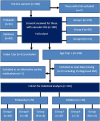Diagnosis and management of vascular Ehlers-Danlos syndrome: Experience of the UK national diagnostic service, Sheffield
- PMID: 36977837
- PMCID: PMC10326011
- DOI: 10.1038/s41431-023-01343-7
Diagnosis and management of vascular Ehlers-Danlos syndrome: Experience of the UK national diagnostic service, Sheffield
Abstract
The UK National Diagnostic Service for Ehlers-Danlos Syndromes (EDS) was established in 2009 for the rare types of EDS. Vascular EDS (vEDS) is an inherited connective tissue disorder caused by pathogenic variants in the COL3A1 gene. Associated tissue fragility affects multiple organ systems, increasing the risk of blood vessel dissection and rupture, with potentially fatal consequences. The diagnosis of vEDS has improved with advances in genetic testing, however this is most often suspected following an acute event. We provide data on the clinical features of vEDS for 180 patients (full cohort) seen in our service with confirmed molecular diagnoses. Increased awareness of this rare condition will prompt genetic testing essential to confirm the diagnosis. Outcomes are improved by early diagnosis followed by appropriate management. Fragile connective tissues make invasive procedures potentially dangerous, particularly in an emergency setting. Lifestyle advice from a young age can help acceptance and understanding of the diagnosis and inform choices. There is currently limited evidence for the use of drug therapy to reduce vascular events. We report on the incidence of vascular events in 126 patients (statistical analysis cohort) in our care and the use of medication. Our retrospective data showed that those patients on a long-term angiotensin II receptor blocker and/or beta-blocker had fewer vascular events than those not on cardiac medication who received the same lifestyle and emergency care advice.
© 2023. The Author(s).
Conflict of interest statement
The authors declare no competing interests.
Figures



Comment in
-
Unusual genomic variants require unusual analyses.Eur J Hum Genet. 2023 Jul;31(7):721-722. doi: 10.1038/s41431-023-01405-w. Eur J Hum Genet. 2023. PMID: 37414865 Free PMC article. No abstract available.
References
Publication types
MeSH terms
Substances
LinkOut - more resources
Full Text Sources
Medical
Miscellaneous

